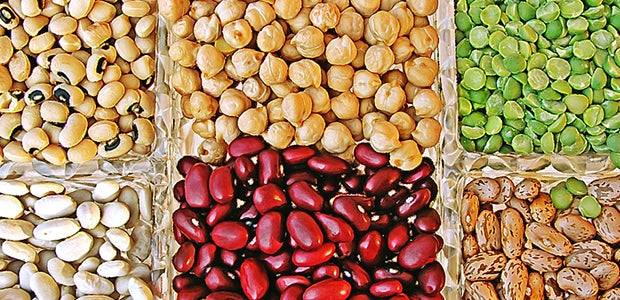Myth: Only vegetarians eat legumes. Reality: in Quebec, eating pea soup and brown sugar baked beans is part of our heritage. With these two statements as a starting point, let's find out what legumes are and if they're right for you.
Legumes under the microscope
Legumes are divided into three main families. After an initial general examination, they are grouped according to their similarities in shape and color:
- The lentils Oval green, brown, black, red, large-caliber blond, broken blond, Puy type.
- The beans and dried beans Small round white, black, Roman, pinto, mungo, adzuki, soybean, gourd seed, cowpea, pink coconut, borlotti, light red kidney, dark red kidney.
- The peas Peas: whole or split yellow, whole or split green. Subgroup: chickpeas, Garbanzo, Kabouli, Kala chana, split peas.
Having used their appearance as a basis for discerning them and choosing the most beautiful specimens to be prepared for eating, let's move on to their virtues and nutritional properties.
High in fiber
Legumes are undoubtedly appreciated for their high content of dietary fiber, carbohydrates and proteins, saturated fats, vitamins and minerals, which, for vegetarians, replace the need for animal meat.
They include two types of digestible fiber in legumes, which are originally podded plants whose seeds are eaten. Fibers soluble fibres to reduce bad cholesterol levels in the blood, and fibre insoluble fiber which facilitate digestion and intestinal transit.
The result is felt in the short term: the sensation of satiety sent to the brain is very rapid, enabling the dieter to wait longer before another meal. Legumes also provide rapid relief from constipation. That's why, if you want to start eating legumes, go slowly, in small quantities at a time, only 2 or 3 meals a week, and drink plenty of water. Of all the legume families, lentils are the easiest to digest and cause the least intestinal discomfort.
Time to choose
Decided to eat legumes, whatever the cost? Whether it's for health reasons, for taste or because they cost less than many meats, you still have another choice to make: dry or canned?
Dried
Let your eye guide you towards smooth, firm, brightly-colored legumes with no blemishes or cracked pods. On the other hand, they require a soaking time that can range from 8 to 12 hours for some (see table below). Dried, they can easily be kept for a year in a cool, dry, airtight jar, away from light. However, the older they are, the more difficult or time-consuming they will be to cook. A word of advice: avoid mixing legumes from different families or bought at different times in the same container, to preserve their freshness and quality.
Canned
Of course, we live in a fast-paced, instantaneous age, so some people prefer canned legumes because they're pre-cooked. All you have to do is rinse them in plenty of water to remove their preservative salt and sugar. Cans that aren't dented or rusty can easily be stored in the pantry for up to a year.
Soaking and cooking times for legumes
If you opt for dried legumes, you'll need to adhere to a set soaking time. There are a few exceptions, such as lentils and split peas, which only need to be rinsed with plenty of water. Normal soaking time is 8 to 12 hours. in the refrigerator. For one part of legumes, you need three parts of cold water, as they tend to swell and even triple in volume. Tip, if you're in a hurry, bring the water to the boil, simmer for 1-2 minutes, leave to stand for an hour and your pulses will be ready for the second stage: cooking. Above all, don't use soaking water or can water for cooking, as it contains too many impurities. So always rinse your pulses before cooking them.
|
Soaking and cooking chart |
|||||
|
|
Beans beans |
Whole peas |
Lentils |
Split peas |
Chickpeas |
|
Soaking |
Yes |
Yes |
No |
No |
Yes |
|
Cooking |
60 to 90 minutes |
60 to 90 minutes |
30 to 45 minutes |
45 minutes |
45 to 60 minutes |
Use a large pot because legumes easily triple in volume during cooking. Use 3 parts water to 1 part beans. Add 1 tsp oil to prevent scumming. Don't overheat to prevent the pods from bursting. At the beginning of cooking, you can add onions and a bouquet garni for extra flavor. And only at the end, season with acidic ingredients such as tomatoes, salt and vinegar.
Time to eat
Now it's time to concoct dishes for your family and friends, such as a pasta and chickpea salad, a black bean burger or oatmeal, legume and chocolate cookies. The list is endless to satisfy your hunger, and you'll feel like you're reinventing tradition as you tame dish after dish of legumes and their benefits.
References
http://www.nospetitsmangeurs.org/legumineuses-101-les-apprivoiser-les-acheter-et-les-conserver/
http://www.monmenu.fr/s/Les-legumineuses-legumes-ou-feculents-aliment-menu-vegetarien-pid214


